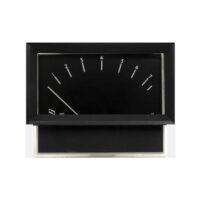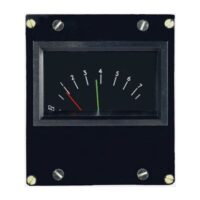

PPM meters
The PPM meter, with the black background and the white scale from 1 to 7 was a standard in UK Broadcast for decades. It was used to establish audio transmission levels and line up.
Each scale number from 1 to 7 represents 4dB, with PPM4 corresponding to 0dBU and PPM6 corresponding to 8dBU. The meter was incredibly easy to read: Speech should peak to PPM6, and maximum transmission should not exceed PPM7, where overload LEDs would often light, and the transmitters would become over modulated.
It uses a taut band movement on a moving coil milliameter, for fast response and slow fall time, which was tightly controlled by a standard BS6840. The EBU used the same scale, but with dB markings instead of 1 to 7.
The earliest drive circuitry was valve based ( yes it has been around that long ) , but solid-state cards were designed to generally fit on the rear of the meter. Early drive cards used precision metering and calibration circuitry with many presets. Later cards embedded the calibration into a small microprocessor. The attack, decay and calibration are closely controlled, so that any particular meter would react the same to music and speech the same as any other.
BCD Audio’s involvement with PPMs started in 1995 with the BCD 950429 stereo drive card.
This has balanced inputs and precision rectification which passed the level to a micro, where calibration, attack/decay, overload and sum/difference switching is implemented. The drive to the meter is by pulse width modulation (PWM) as the micro did not have DtoA converters, which are expensive anyway.
The circuitry was built into the BCD950824 Monitor Eurocard, and also a simple mono drive card BCD950409. A phase detector card was also designed BCD960511, and later incorporated into the monitor card.
In 2003, the BBC approached us for an AES3 equivalent card, and the iPPM BCD030624 was born.
An AES3 receiver decodes the audio stream which passes to a simple but fast micro, the SX28. Many jumper plugs were defined, as the headroom standard for digital consoles was subject to experimentation at the time. Sum/Difference and LED overloads were implemented, and the PWM drive retained. Two presets calibrated the meter, and were set to match the tolerance of the mechanical meter.
The card was specified for Radio consoles for over 10 years. The later ranges of consoles switched to plasma and on-screen displays and the market for Analogue meters faded.
The display and PPM calibration lives on in bar-graphs and on-screen displays; it survives because the Meter dynamics matches the real world of speech and music much better than the VU. Modern compressed music and the tendency to push signals up to 0dFS limits its usefulness today; bar-graphs have to extend the display all the way to 0dFS; Something the original meter designers did not need to worry about!
PPM Items for sale in the webshop
( While stocks last. All new and unused )
| Sifam AL32 | Mono meter with back mounting kit | Buy Now >> |
| Sifam AL14 | These have size about 45 x 40mm | Buy Now >> |
| Sifam 74B | Stereo meter, with red, green needles. | Buy Now >> |
| BCD030624-I | Illumination kit for 74A or B meters. Uses White surface mount LEDs and circuit board replaces the glass. 5V PSU | Buy Now >> |
| BCD030624-B1 | iPPM drive card. AES3 input, Mounts on 74B | Buy Now >> |
| BCD950429 | Stereo PPM drive card, Analogue | Buy Now >> |
| BCD090217/030228 | Illumination kit for 74A or B meters. Uses White surface mount LEDs and circuit board replaces the glass. 15V PSU | Buy Now >> |
| BCD950409 | Mono PPM drive card, Analogue | Buy Now >> |
| BCD960511 | Phase detector card, drives bicolour LED | Buy Now >> |
We also used to make an illumination board with white surface mount LEDs for the back-mounted AL32 Meter : Please contact Sales if you need some.
